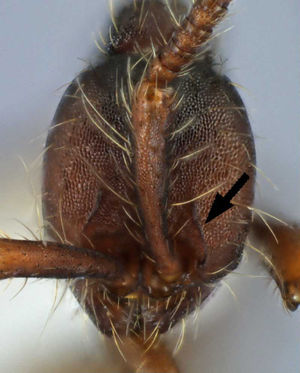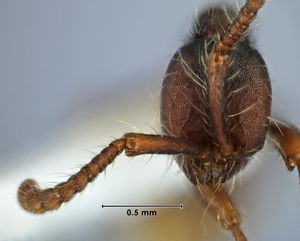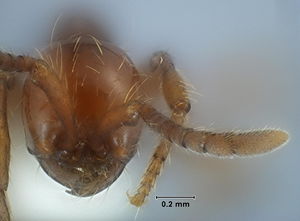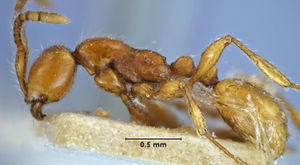Key to Australian Aenictus Species
The following key to Australian Aenictus is based on Shattuck (2008[1]). This key is worker-based and A. hilli, known only from males, is not included.
1
- A ridge (parafrontal ridge) present on the front of the head starting between the antennal and mandibular insertions and extending posteriorly; head capsule varying from smooth posteriorly and weakly punctate between the frontal carinae and above the mandibular insertions to completely punctuate => 2
- Area between antennal and mandibular insertions smooth or at most slightly angular but never ridged (parafrontal ridge absent); head capsule entirely smooth => 3
2
- Pronotum with large smooth areas dorsally and laterally, other areas micro-reticulate => Aenictus philiporum
- Pronotum entirely sculptured with dense micro-reticulations => 4
3
- Head with large pale patches near the posterolateral corners; subpetiolar process generally absent but sometimes present as a slight carina => Aenictus diclops
- Head essentially uniform in colour; subpetiolar process large and rectangular => 5
4
- Scape relatively long (scape index > 107) => Aenictus nesiotis
- Scape relatively short (scape index < 103) => Aenictus aratus
5
- Scape relatively long (scape index > 89) => Aenictus prolixus
- Scape relatively short (scape index < 91) => 6
6
- Body larger (HW > 0.62mm); sculpturing on pronotum extending posteriorly onto the main pronotal body => Aenictus acerbus
- Body smaller (HW < 0.62mm); sculpturing on pronotum limited to the anterior sections around the collar, the main body of pronotum smooth => Aenictus turneri
References
- ↑ Shattuck, S.O. (2008). Review of the ant genus Aenictus (Hymenoptera: Formicidae) in Australia with notes on A. ceylonicus (Mayr). Zootaxa, 1926, 1–19.
















